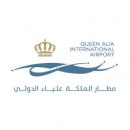Queen Alia International Airport Receives One of the World’s Largest Aircrafts
Queen Alia International Airport Receives One of the World’s Largest Aircrafts
Airport International Group (AIG), the Jordanian consortium responsible for the rehabilitation, expansion, and operation of the Queen Alia International Airport (QAIA), welcomed one of the world’s largest aircraft, the Antonov AN-124, on April 19.
The Antonov AN-124 is a jumbo cargo aircraft with payload capacity of up to 150 tons and a range of 5,000 km. This 405,000 kg heavy transport aircraft has two distinctive features; a fuselage nose that can be hinged upwards to open the front cargo hatch and a cargo hatch in the rear fuselage. The Antonov AN-124 entered service in 1986 and more than 55 aircraft have been built.
Airports serving this type of aircrafts must accommodate its wide dimensions with specially designed taxiways, emergency fire-fighting equipment, and other necessities. Prior to the arrival of the aircraft, AIG had made special preparations to receive the unique jumbo aircraft, which included inspecting the runway and arranging a guide vehicle to ensure that the aircraft reached the cargo processing area safely once it had landed. The cargo area itself was inspected for debris before the Antonov arrived.
The successful reception of the Antonov is an excellent opportunity for the QAIA to attract other jumbo aircraft for passenger, commercial, and cargo flights, thereby adding to the airport’s sustained growth. Last month QAIA received the Cargolux Boeing 747-8, the latest model in Boeing’s world-renowned line of jumbo jets.
AIG recently announced the traffic results for the first quarter of 2012; the number of travelers coming through Jordan’s premier airport exceeded 1.5 million passengers, a 24% increase from same period in 2011. Aircraft movements (ACMs) reached over 15,000, representing a 7% increase from the same time in 2011, while cargo reached over 21,000 tons, a 4.5% increase from same period last year. AIG’s investment of US $750 million to build a new terminal – in addition to US $100 million spent on rehabilitating the terminals currently in use – is intended to develop the QAIA as a regional niche hub and turn the airport into a national landmark.


